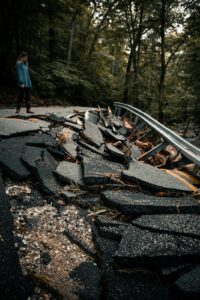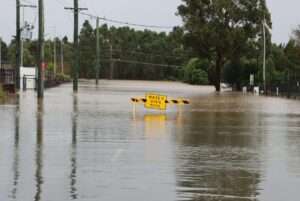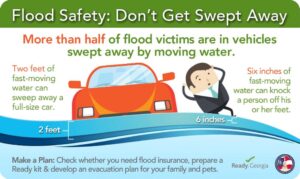Heather N. Kolich, ANR Agent, UGA Extension Forsyth County

According to the Georgia Emergency Management and Homeland Security Agency (GEMA), severe thunderstorms and flooding are the most common natural disasters in Georgia. As almost the entire state is under a state of emergency due to Hurricane Helene and the anticipated heavy rains that will accompany the storm, let’s talk about flood emergency preparation and safety.
Terms of flood concern
The National Weather Service issues alerts about potential dangerous weather conditions, including floods. Alert messages include different words – watch, advisory, or warning – to indicate the level of danger.
Watch– A flood watch means that widespread flooding is possible in the area specified in the alert. The flood is expected to happen 6-12 hours after heavy rains end.
Advisory – A flood advisory is a notification that floodwaters may be present and may disrupt daily routines and hamper traffic.
Warning– Warning indicates both a higher level of danger and a more immediate event. A flood warning means that flooding is expected in the area within 6-12 hours. Local authorities may order an immediate evacuation of the area.

Types of floods
Floods occur when water overflows onto land that is normally dry. The Federal Emergency Management Agency (FEMA) identifies four types of flooding.
Flash flooding – Usually, floods develop slowly over several days. Flash floods, however, can develop into raging torrents in a matter of minutes. They are usually caused by heavy and/or excessive rainfall that occurs over less than six hours; however, a dam failure can also release a sufficient volume of water to create a flash flood. The water of flash floods roars down riverbeds and urban streets, carrying rocks, mud, and debris that can sweep away objects, animals, and people.
River and stream flooding – Heavy rains, storm surge, and melting snow can cause rivers and streams to overtop their banks, resulting in flooding of adjacent land.
Closed-basin flooding – Under storm conditions and seasonal rainfall, the level of water in lakes and ponds can rise faster than it empties through overflow outlets.
Coastal flooding – Along coastlines, offshore storm systems can push ocean water inland above the normal tide level, causing a storm surge. Like flash floods, a storm surge can happen in a matter of minutes.

Preparing for a flood
Develop a family plan for evacuation situations. Since floods can impede roads, learn and practice several alternate routes for your normal commutes and for your evacuation destination. Prepare a ready-to-go kit with emergency essentials, a list of emergency contacts, and copies of important documents, such as insurance policies. Designate a location away from the flood area to meet up with family members who may be unable to get home due to flooded roads.
If time allows, move furniture and valuable to upper floors to mitigate damage from floodwaters entering the house.
Safety during flooding
Floodwaters don’t have to be deep to be dangerous. Listen to a weather alert radio or local news station for flood and evacuation information. If you must leave your location:
- Never drive through standing water. Cars can float away in water just 1-foot deep.
- Do not drive around road barricades. Follow detour and evacuation routes.
- Move to higher ground, away from rivers, streams, creeks, dams, and storm drains.
- Stay out of flood waters.
- Six inches of flood water can sweep you off your feet.
- Flood waters may be contaminated or electrically charged.
- Stay away from downed power lines.
Recovering after flooding
Stay away from flooded areas until local authorities say it is safe to reenter. Floodwaters can weaken roads, bridges, and buildings enough to cause them to collapse. Drinking water may also be contaminated. Throw away all food that has been in contact with flood waters unless it is sealed in waterproof containers that can be cleaned and sanitized. If you rely on well water for drinking, use bottled water until you can test and treat the well water for contaminants.